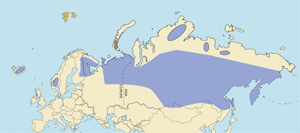 |
 |
Rangifer tarandus
Reno (Sp), Wildren (G), Renne sauvage (F). The reindeer is the same species as the caribou of North America, and is very similar.
DESCRIPTION (male) Shoulder height 39-47 inches (99-119 cm). Weight 150-330 pounds (68-150 kg). Females are about one-third smaller.
Wild reindeer in Europe are slightly smaller than most North American caribou. Reindeer are moderately large deer with the most antler growth in comparison to body size of any antlered animal. They are unique in that both sexes grow antlers, those of the female being small and spindly. The antlers are fully developed in September, are shed by males December-January, by juveniles toward spring, and by females in early summer. Males usually have a vertically palmated brow tine (called "shovel" in North America) on one antler, and sometimes on both. The upper tines are often palmated, and there usually is a back tine halfway up the antler. Reindeer have a broad muzzle, a throat mane and a short tail. The hoofs are wide and deeply cleft for walking on soft ground and snow. Reindeer make a clicking sound when walking, which is caused by a tendon slipping over a bone in the foot. The coat consists of a heavy undercoat covered by straight, tubular guard hairs that contain air cells. Most individuals are dark grayish-brown in summer, changing to pale gray in winter with the neck white. Reindeer in the far northern regions are sometimes nearly all white. Domesticated reindeer are smaller than wild specimens and highly variable in color.
BEHAVIOR Highly gregarious, with females and young forming large herds. Mature males are solitary or in small groups, joining the herds during the rut in late September-October and attempting to form harems. Calves (usually one) are born in May. Mainly diurnal, feeding on whatever is available, but concentrates on lichens in winter. Eyesight is poor, hearing fair, sense of smell very good. Not particularly wary. Not an especially fast runner, but has great endurance. Fast swimmer, floating high in the water because of its hollow hairs. Principal predator is the wolf, the only animal able to run down an adult reindeer in a long chase.
HABITAT Tundra, mountain heath, and taiga forest.
DISTRIBUTION Wild reindeer are found in Svalbard; in the Njardaheim Reserve, Hardangervidda plateau and Dovrefjell mountains in southern Norway; from eastern Finland eastward across northern Russia; and have been introduced in Iceland.
Outside Europe, wild reindeer are also found in northern Asia.
Domesticated and feral reindeer are found in Norway, Sweden, Finland and Siberian Russia, and have been introduced in Scotland, Greenland, Canada, Alaska, Argentina, Chile, and the oceanic islands of South Georgia and Kerguelen.
TAXONOMIC NOTES Scientists recognize a single species of reindeer or caribou worldwide, with about 8-10 subspecies. European subspecies include: European reindeer (R. t. tarandus), from Norway, Finland, and Russia east to the Ural Mountains, and also in Iceland (introduced); Spitzbergen reindeer (R. t. platyrhynchus), a small race from Svalbard; and Novaya Zemlya reindeer (R. t.pearsoni), a small race from the Russian island of Novaya Zemyla that turns almost completely white in winter. We do not separate them.
REMARKS Wild reindeer are important game animals in Norway, although not as much so as moose. Norwegian reindeer hunts are done on foot with single-shot rifles, and are highly sporting propositions. Reindeer in Sweden are domesticated or enclosed. Most reindeer in Finland are domesticated, but there is also a small wild herd that is strictly protected. As far as we know, reindeer are not available to foreign sportsmen in European Russia. Wild reindeer have been introduced in Iceland, where they provide good sport in magnificent surroundings. As their antlers do not grow as large as those on the European mainland, we have placed them in a separate category with a lower minimum score.
|





